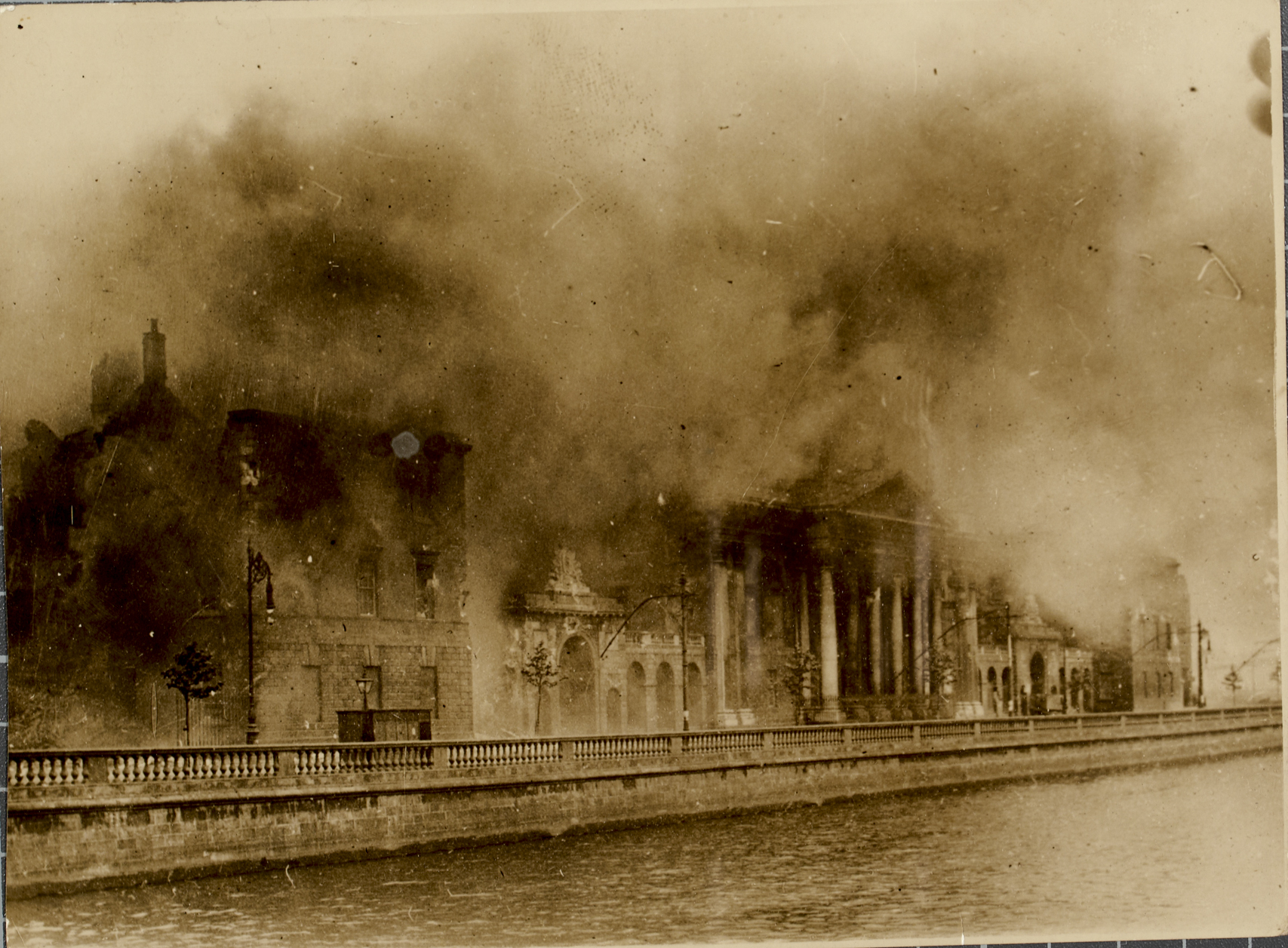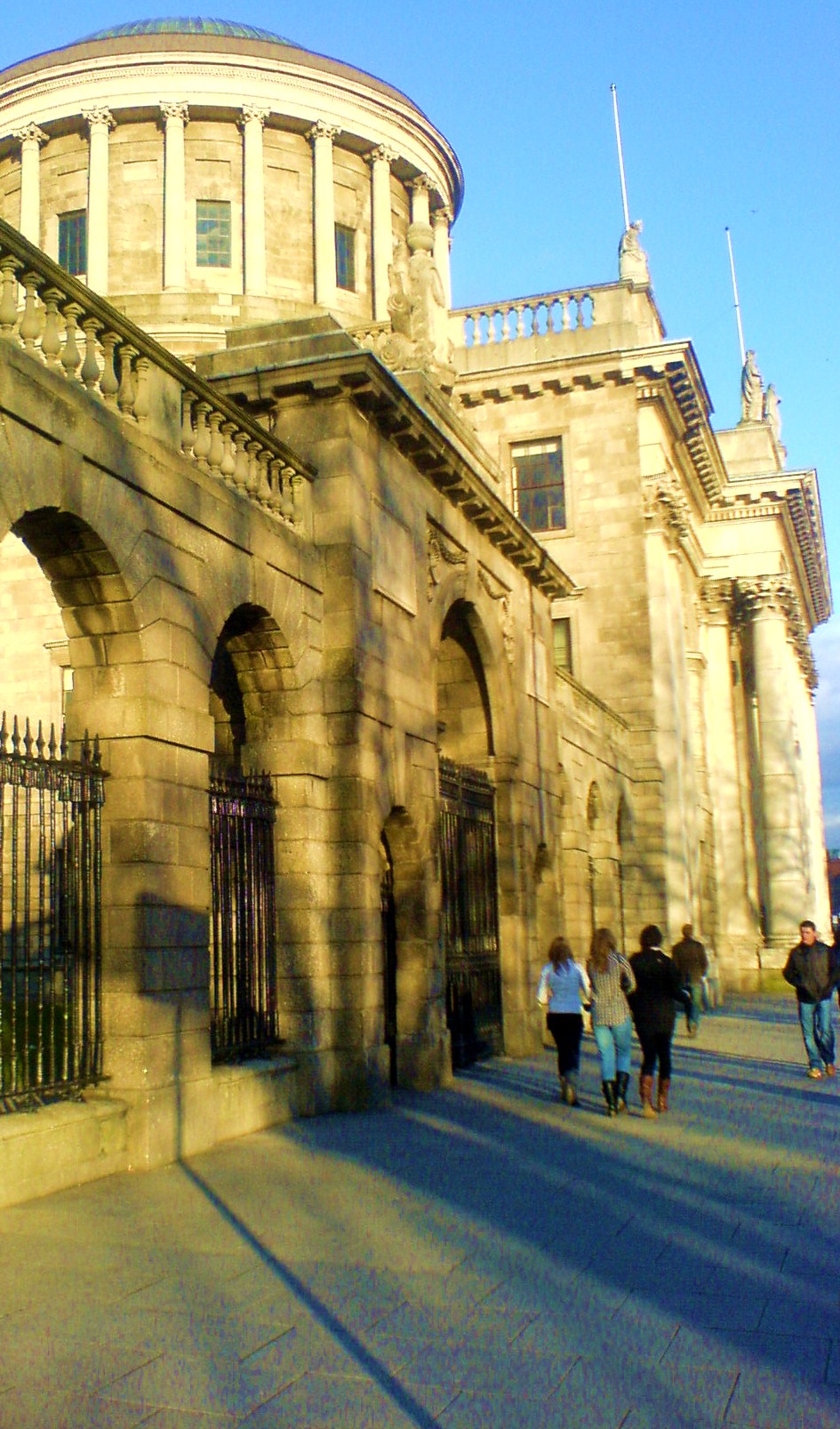Four Courts on:
[Wikipedia]
[Google]
[Amazon]
The Four Courts ( ga, Na Ceithre Cúirteanna) is Ireland's most prominent courts building, located on
 On 14 April 1922 the courts complex was occupied by IRA forces opposed to the Anglo-Irish Treaty, with Rory O'Connor acting as their spokesman. On 28 June the new National Army attacked the building to dislodge the "rebels", on the orders of the Minister for Defence Richard Mulcahy, authorised by President of Dáil Éireann Arthur Griffith.'The Republic – the Fight for Irish Independence 1918–1923' Charles Townshend This attack provoked a week of fighting in Dublin. In the process of the bombardment, the historic building was destroyed. The west wing of the building was obliterated in a huge explosion, destroying the Irish
On 14 April 1922 the courts complex was occupied by IRA forces opposed to the Anglo-Irish Treaty, with Rory O'Connor acting as their spokesman. On 28 June the new National Army attacked the building to dislodge the "rebels", on the orders of the Minister for Defence Richard Mulcahy, authorised by President of Dáil Éireann Arthur Griffith.'The Republic – the Fight for Irish Independence 1918–1923' Charles Townshend This attack provoked a week of fighting in Dublin. In the process of the bombardment, the historic building was destroyed. The west wing of the building was obliterated in a huge explosion, destroying the Irish
 For a decade after the destruction of the Civil War, the courts sat in the old viceregal apartments in
For a decade after the destruction of the Civil War, the courts sat in the old viceregal apartments in
, Dearbhail McDonald,
, Carol Coulter,
Four Courts web tourCourts Service of IrelandThe Bar CouncilThe National Archives of Ireland
{{Judiciary of the Republic of Ireland Buildings and structures in Dublin (city) Courthouses in the Republic of Ireland National supreme court buildings Neoclassical architecture in Ireland Rebuilt buildings and structures
Inns Quay
The Dublin quays () refers to the two roadways and quays that run along the north and south banks of the River Liffey in Dublin, Ireland. The stretches of the two continuous streets have several different names. However, all but three of the ...
in Dublin
Dublin (; , or ) is the capital and largest city of Ireland. On a bay at the mouth of the River Liffey, it is in the province of Leinster, bordered on the south by the Dublin Mountains, a part of the Wicklow Mountains range. At the 2016 ...
. The Four Courts is the principal seat of the Supreme Court
A supreme court is the highest court within the hierarchy of courts in most legal jurisdictions. Other descriptions for such courts include court of last resort, apex court, and high (or final) court of appeal. Broadly speaking, the decisions of ...
, the Court of Appeal, the High Court and the Dublin Circuit Court. Until 2010 the building also housed the Central Criminal Court; this is now located in the Criminal Courts of Justice building.
Court structure
The building originally housed four superior courts, ofChancery
Chancery may refer to:
Offices and administration
* Chancery (diplomacy), the principal office that houses a diplomatic mission or an embassy
* Chancery (medieval office), responsible for the production of official documents
* Chancery (Scotlan ...
, King's Bench, Exchequer and Common Pleas, giving the name to the building.
Under the Supreme Court of Judicature Act (Ireland) 1877, these four courts were replaced by two - the Court of Appeal, presided over by the Lord Chancellor
The lord chancellor, formally the lord high chancellor of Great Britain, is the highest-ranking traditional minister among the Great Officers of State in Scotland and England in the United Kingdom, nominally outranking the prime minister. T ...
, and the High Court of Justice
The High Court of Justice in London, known properly as His Majesty's High Court of Justice in England, together with the Court of Appeal and the Crown Court, are the Senior Courts of England and Wales. Its name is abbreviated as EWHC (Englan ...
, headed by the Lord Chief Justice
Lord is an appellation for a person or deity who has authority, control, or power over others, acting as a master, chief, or ruler. The appellation can also denote certain persons who hold a title of the peerage in the United Kingdom, or ...
- but the building has retained its historic name.
Under the Courts of Justice Act 1924, courts were established for the new Irish Free State
The Irish Free State ( ga, Saorstát Éireann, , ; 6 December 192229 December 1937) was a State (polity), state established in December 1922 under the Anglo-Irish Treaty of December 1921. The treaty ended the three-year Irish War of Independ ...
with the Supreme Court of Justice, presided over by the Chief Justice, replacing the Court of Appeal and a reconstituted High Court of Justice
The High Court of Justice in London, known properly as His Majesty's High Court of Justice in England, together with the Court of Appeal and the Crown Court, are the Senior Courts of England and Wales. Its name is abbreviated as EWHC (Englan ...
, presided over by the President of the High Court, continuing the jurisdiction of the old High Court. The Constitution of Ireland in 1937 provided that courts would be established in a manner provided by the Constitution; this did not in fact occur until the implementation of the Courts (Establishment and Constitution) Act 1961. The Supreme Court
A supreme court is the highest court within the hierarchy of courts in most legal jurisdictions. Other descriptions for such courts include court of last resort, apex court, and high (or final) court of appeal. Broadly speaking, the decisions of ...
and High Court (now dropping "of Justice" from their title) established under this act continued the jurisdiction of the courts established under the 1924 Act.
A new Court of Appeal was established in 2014, following a referendum in 2013, largely taking over the appellate jurisdiction of the Supreme Court and the old Court of Criminal Appeal. Its civil division sits in the Four Courts.
History
Gandon's building
left, 160px, Part of the original Gandon-designed interior decoration of the dome, lost in the 1922 destruction Work, based on the design of Thomas Cooley for the Public Records Office of Ireland, began in 1776. After his death in 1784 renowned architect James Gandon was appointed to finish the building which we recognise today as the Four Courts. It was built between 1786 and 1796, while the finishing touches to the arcades and wings were completed in 1802, The lands were previously used by the King's Inns. and before that a 13th century Dominican FriarySt. Saviour's
ST, St, or St. may refer to:
Arts and entertainment
* Stanza, in poetry
* Suicidal Tendencies, an American heavy metal/hardcore punk band
* Star Trek, a science-fiction media franchise
* Summa Theologica, a compendium of Catholic philosophy ...
was located on the site, confiscated following the dissolution of the monasteries by Henry VIII.
Easter Rising
The Four Courts and surrounding areas were held by Commandant Edward Daly's 1st Battalion during the Easter Rising in 1916. Some of the most intense fighting of Easter Week took place in the Church Street/North King Street/North Brunswick Street area. At the end of the week, the Four Courts building itself became the headquarters of the 1st Battalion.Destruction in Civil War
 On 14 April 1922 the courts complex was occupied by IRA forces opposed to the Anglo-Irish Treaty, with Rory O'Connor acting as their spokesman. On 28 June the new National Army attacked the building to dislodge the "rebels", on the orders of the Minister for Defence Richard Mulcahy, authorised by President of Dáil Éireann Arthur Griffith.'The Republic – the Fight for Irish Independence 1918–1923' Charles Townshend This attack provoked a week of fighting in Dublin. In the process of the bombardment, the historic building was destroyed. The west wing of the building was obliterated in a huge explosion, destroying the Irish
On 14 April 1922 the courts complex was occupied by IRA forces opposed to the Anglo-Irish Treaty, with Rory O'Connor acting as their spokesman. On 28 June the new National Army attacked the building to dislodge the "rebels", on the orders of the Minister for Defence Richard Mulcahy, authorised by President of Dáil Éireann Arthur Griffith.'The Republic – the Fight for Irish Independence 1918–1923' Charles Townshend This attack provoked a week of fighting in Dublin. In the process of the bombardment, the historic building was destroyed. The west wing of the building was obliterated in a huge explosion, destroying the Irish Public Record Office
The Public Record Office (abbreviated as PRO, pronounced as three letters and referred to as ''the'' PRO), Chancery Lane in the City of London, was the guardian of the national archives of the United Kingdom from 1838 until 2003, when it was ...
at the rear of the building. Nearly a thousand years of archives were destroyed by this explosion, the ensuing fire, and the water poured onto the fire.
The IRA was accused of mining the records office; however, those present, who included future Taoiseach Seán Lemass, said that, while they had used the archive as a store of their ammunition, they had not deliberately mined it. They suggest that the explosion was caused by the accidental detonation of their ammunition store during the fighting.
Reopening in 1932
Dublin Castle
Dublin Castle ( ga, Caisleán Bhaile Átha Cliath) is a former Motte-and-bailey castle and current Irish government complex and conference centre. It was chosen for its position at the highest point of central Dublin.
Until 1922 it was the ...
. In 1932, a rebuilt and remodelled Four Courts was opened. However, much of the decorative interior of the original building had been lost and, in the absence of documentary archives (some of which had been in the Public Records Office and others of which were among the vast amount of legal records lost also), and also because the new state did not have the funds, the highly decorative interior was not replaced.
Further development
The Office of Public Works added a modern two-storey extension to the roof of the old Public Records Office in the late 1960s. They also built River House on Chancery Street, which served as Dublin's only motor tax office for a number of years.Criminal courts
Prior to 2010, both civil and criminal trials were heard in the Four Courts, which was also the location of the Court of Criminal Appeal. When the Criminal Courts of Justice building, near the Phoenix Park, opened in January 2010, all criminal trials were transferred there.New order in court as €140m legal 'Pantheon' opens doors, Dearbhail McDonald,
Irish Independent
The ''Irish Independent'' is an Irish daily newspaper and online publication which is owned by Independent News & Media (INM), a subsidiary of Mediahuis.
The newspaper version often includes glossy magazines.
Traditionally a broadsheet n ...
, 24 November 2009First case set for new criminal courts, Carol Coulter,
The Irish Times
''The Irish Times'' is an Irish daily broadsheet newspaper and online digital publication. It launched on 29 March 1859. The editor is Ruadhán Mac Cormaic. It is published every day except Sundays. ''The Irish Times'' is considered a newspaper ...
, 24 November 2009 The Four Courts remain in use for civil matters.
Plans for Supreme Court building
There are plans to relocate the Supreme Court to a new purpose-built building near the Four Courts.See also
* Courts of the Republic of Ireland * Law of the Republic of IrelandReferences
External links
Four Courts web tour
{{Judiciary of the Republic of Ireland Buildings and structures in Dublin (city) Courthouses in the Republic of Ireland National supreme court buildings Neoclassical architecture in Ireland Rebuilt buildings and structures